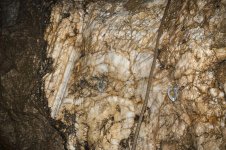Simon Wilson
New member
SamT said:On the other side of the coin.. I gave some 8mm ones to a mate to equip a new climbing route at Kinsley. The idea being to trial placement then replace with resin bolts whrn the route had been worked and the most ideal clipping points fine tuned.
He came back saying the were shit and that he'd sheared a couple trying to get them to cut a thread. I suspect the limestone there is bullet hard compared with the peak limestone 'cheese'.
I've certainly struggled to get them to cut into hard red brick and sheared one.
Your mate could easily be in the running for the Darwin Awards.
Kilnsey Crag is Great Scar Limestone which is a relatively uniform limestone of medium hardness (around 4 on the Mohs scale) and takes concrete screws very well, as my testing shows.
braveduck said:The secret is drilling the hole the right size ,
running drill in and out several times and making sure the hole is clear of dust.
If it gets tight when going in ,remove and and run the drill in and out a few more times.
I think they are brilliant.
There is no 'secret'. The manufacturers give instructons on installation. Just like any piece of gear, users should read the instructions. Anyone planning to use concrete screws should find out how to install them and only install them when they are confident that they know what they are doing. Practice in concrete before damaging our caves and crags.
In addition to what Dave said, as well as being the correct diameter and clean the hole needs to be sufficiently deep. Do not use the cheapo Chinese screws.




